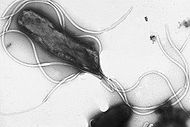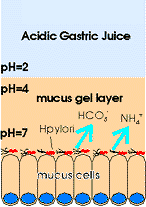HELICOBACTER PYLORI
 Helicobacter pylori is a spiral shaped bacterium (about 3 micrometres long with a diameter of about 0.5 micrometres) that lives in the stomach and duodenum. It has a unique way of adapting in the harsh environment of the stomach. The inside of the stomach is comprised of gastric juices whose main components are digestive enzymes and concentrated Hydrochloric acid. The main purpose of gastric juice is to breakdown the food and to kill the micro-organisms, if any. Hence, before the detection of H.Pylori it was thought that stomach is actually sterile. The figure to the right shows the Electron micrograph of H. pylori.
Helicobacter pylori is a spiral shaped bacterium (about 3 micrometres long with a diameter of about 0.5 micrometres) that lives in the stomach and duodenum. It has a unique way of adapting in the harsh environment of the stomach. The inside of the stomach is comprised of gastric juices whose main components are digestive enzymes and concentrated Hydrochloric acid. The main purpose of gastric juice is to breakdown the food and to kill the micro-organisms, if any. Hence, before the detection of H.Pylori it was thought that stomach is actually sterile. The figure to the right shows the Electron micrograph of H. pylori. HOW H.PYLORI PROTECTS ITSELF

MODES OF TRANSMISSION
The exact route of transmission is still under research however it is strongly believed that H.Pylori is transmitted via the oral-oral or fecal-oral route. Gastro-esophalgal reflux is also a known cause of transmittance of this bacterium. In the United States, 30% of the adult population is infected. (50% of infected persons are infected by the age of 60.) The infection is more common in crowded living conditions with poor sanitation. In countries with poor sanitation, 90% of the adult population can be infected. Shown below is a slideshow of the endoscopic images of H.Pylori induced gastritis.
Endoscopy Slide Show:
|


